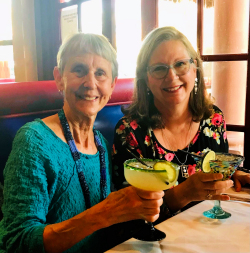

Diane Elizondo and Diane O’Connor met in 2002 in Vancouver, WA after they had both been diagnosed with ovarian cancer and were in treatment. They were excited to meet a fellow ovarian cancer survivor and wanted to move forward with a plan. So, in 2005 they started the Ovarian Cancer Alliance of OR/SW WA as an official 501c3 non-profit organization. The rest is history! The organization has grown and expanded to include education, awareness, support, and advocacy. In this issue you will find the In Her Own Words stories from both Dianes, with updates from each of them.
Diane Elizondo:
Before I was diagnosed myself, I had some knowledge of ovarian cancer, unlike many women. Two of my friends had died of ovarian cancer: one in her 30’s and the other in her mid-40’s. I had also been a hospice social worker and had some knowledge that way.
So one day in 2002, I was at work when I experienced pelvic pain that was so intense that I couldn’t even sit down. I went immediately to my internal medicine doctor who started talking about the possibility of diverticulitis. But I told him “no,” as I felt strongly that it wasn’t anything like that. To my doc’s credit, he listened to me and referred me to a gynecologist, and sent me to get a pelvic and transvaginal ultrasound.
The results showed that both of my ovaries were enlarged. I told the gynecologist that I was worried about ovarian cancer but he assured me that it was very unlikely and wanted to wait a month to see if the problem resolved itself.
One month later, my ovaries had increased in size and I was scheduled for a surgery. Following the surgery, at which my uterus, fallopian tubes and ovaries were removed, I was told that I didn’t have ovarian cancer as my ovaries had looked good.
On my first day home following the surgery, the gynecologist called to tell me the pathology report concluded that I had a grade 3 tumor in each ovary. One month later, I underwent a second surgery, this time with a gynecologic oncologist who performed a complete staging laparotomy. I was staged a 1B and sent for 6 cycles of taxol/Carboplatin due to the high grade (3) tumors that were in each ovary.
I really feel that my two ovarian cancer angels (my two friends who had died) were perched on my shoulders the day I had the intense pelvic pain and went to see my doctor. I believe that if I hadn’t known what I did about ovarian cancer, I wouldn’t be here today.
This is why it is important that all women are educated about the signs and symptoms of ovarian cancer. Early detection is so important, and can make a difference.
Since 2005, I have retired, have three grandchildren, still love to sleep in and have met so many wonderful survivors.
Diane O’Connor:
In March 2001 I began training for the week long Cycle Oregon which takes place every September. During those months I had been noticing more frequent urination, diarrhea, abdominal bloating, pelvic discomfort, and lots of gas — all of which I attributed to too much Gatorade and the anticipation of the “big ride.”
Two months after the ride (December 2001), the symptoms continued, and I noticed more bloating and diarrhea. I was to leave for my son’s graduation at the University of Hawaii but decided I should first make a quick trip to my general practitioner to get something for these annoying symptoms. When I described the symptoms, she thought it might be IBS, irritable bowel syndrome, and gave me a prescription.
The two weeks in Honolulu were miserable from a physical standpoint — more gas, bloating, and diarrhea. At this point I began to fear the worst and considered the possibility of colon cancer which had killed my father at age 59. Yet, I had had a colonoscopy several years before. What was going on with my body? Could this just be post-menopause?
On December 31, 2001, I saw my regular gynecologist for my annual exam. During the pelvic exam she found a mass the size of a large grapefruit, which she thought might be a fibroid. She immediately ordered a transvaginal ultrasound. The ultrasound technician explained that the results would be sent to my doctor and that I would be notified in about a week.
No sooner had I returned home from the appointment than my gynecologist called. She explained that the ultrasound showed that the growth was on the left ovary and it was not a cyst. She added that she had made an appointment for me that week with an outstanding gynecologic oncologist in Portland. I was to report to the hospital lab for a CA125 blood test. The CA125 test registered 1600; the normal range is below 30.
Three days after the appointment with the gynecologic oncologist, I had a complete hysterectomy and debulking surgery. I woke up to the diagnosis of Stage IIIC ovarian cancer. The cancer had already metastasized to my lymph nodes. The gyn onc connected me with a medical oncologist in Vancouver, and thus began the chemo journey — the standard six rounds of carboplatin and taxol. After that, both my doctors recommended that I continue with 12 more months of a consolidated taxol treatment, which I completed in April 2003.
I have been extremely fortunate to remain in remission since then.
In 2014-15 I served as Board President for the Ovarian Cancer National Alliance in Washington DC. I then served on the Board of Directors for the Ovarian Cancer Research Alliance in New York City. I feel so fortunate to have four beautiful granddaughters whom I get to see in California and Bellevue, WA. now that I am Covid-vaccinated!
